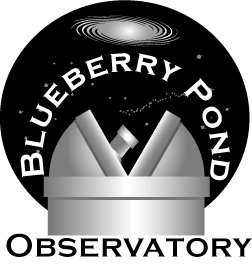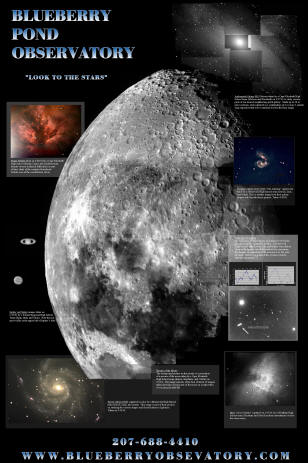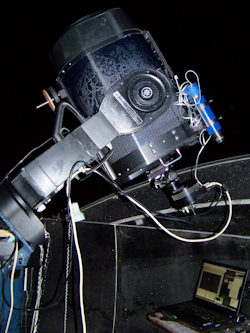-

-
Blueberry Pond Observatory
BPO can automate observations for all night work
-





Visitors at BPO can now conduct advanced astronomy projects by using the autonomous robotic systems to control the telescope and digital camera for extended operations throughout the entire night. This allows very detailed and exciting projects to be executed on and off site for less cost than ever before.
Here is a screen shot showing a robotic executed script for a "mosaic" of the Andromeda Galaxy region of the sky, capturing 35 images while focusing, locking on to guide stars, and other "support" operations totally automatically.
| Meade RCX400 12" Telescope | At the heart of the observatory is our new RCX400 12" Meade telescope. This computerized telescope shows sharp undistorted images to both the eye and the camera. It can be operated by a hand control, computer star chart software, and by a robotic scripting system that can capture a series of images all night long without a human operator present. The system will analyze where it is pointing, focus automatically, center on desired targets, and capture images for all parts of the sky. The RCX 400 is a improvement on every aspect of operating its predecessor the Meade LX200 telescope series. |
| ACP Observatory Control Software for autonomous robotic use. | The ACP software is the newest system at BPO.
It allows anyone to create a script of targets for a whole nights
worth of image capturing. The system can then be started and
left to run all night without human intervention. Each set of
coordinates in the script will be targeted and captured
Periodically the camera will be refocused by the system to keep
images sharp. The software will recheck the coordinates it is
aimed at by analyzing stars in the new images with stellar catalogs,
and the telescope's aim will be adjusted as needed. This allows advanced users at the observatory to conduct long large projects such as measuring asteroid rotation with ease. |
| SBIG ST-7E CCD Camera | The ST-7E CCD camera actually has two cameras in it... one for taking images, and a smaller camera to make tracking corrections during long exposures. The high resolution of the camera has 9um pixels, which translates to about 0.6 arc second pixels at F8 on the 12" telescope, or 1.2 arc seconds each at F4. The effective field of view is 7 arc minutes 47 arc seconds by 5' 11" for F8, 23'36" by 15'4" for F3.3. |
| MaximDL, The Sky 6 |
Great software for visitors of all experience levels find astronomy targets in the sky, control the telescope, capture and process their digital astronomy pictures. |
| Optec MaxFilter system | Sets of three colored filters can be inserted into the light path of the telescope. The filters are designed to be parafocal, so filters can be alternated without refocusing the telescope. Filters for color work, bright object work, and special light conditions are available, along with Infra Red and Ultra Violet rejecting filters. |
| Optec Max 5 wide angle | The Optec 5 Max wide angle eyepiece allows the ST-7E CCD camera to be used with the telescope as either F8 or as F4 The result is a much wider field of view. An even wider field of view is available via the Max 3.3 wide angle adaptor, with the down side of distortion for stars towards the edges of the view. |
| Various support systems | A variety of lenses are available for visual viewing through the telescope. Dew removers prevent dew or frost problems. Secondary focusing systems allow precise focusing of the CCD camera. Regular film cameras can also be used with the telescope. |
| 12 foot Astro Haven Dome | The observatory enclosure is a 12 foot fiberglass shelter that opens like a clam shell. The south, north, or both directions can be opened for a view of the sky. Leaving one side up serves as a wind break when needed. Unlike a conventional observatory, the dome does not need to be rotated each time the telescope is aimed at a different part of the sky. |
| Large warm control Room | A set of normal stairs (not attic stairs) descend from the observatory to a warm control room below. In this room are a second set of controls to operate the telescope and CCD camera while warm and comfortable. Plenty of books are on hand for reference, and you can even watch TV or use another computer during long exposures with the camera. |
| Various computer systems | The telescope and camera are controlled via a Gateway Pentium II 300Mhz Laptop computer. "The Sky version 4" is used as a star charting program to see what targets are above the horizon, etc. Most CCD operations are done using "Maxim DL". The laptop is set up to be used simultaneously from beside the telescope, and below in the warm room. |
| Previous telescope (1999 through 2008) Meade LX200 12" Telescope |
LX200 telescopes are well known for their ability to easily put a target object in the small CCD camera field of view with a minimum of fuss. The telescope is polar mounted to allow long exposures, and the motors are periodically calibrated to minimize tracking errors. All cables and accessories are pre-wired for instant setup and use. |